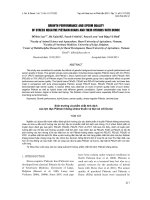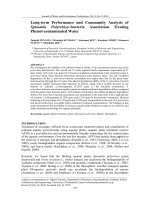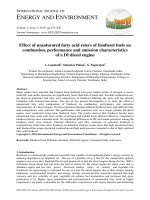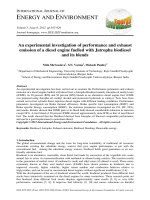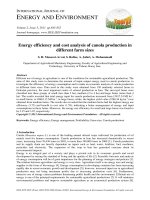Long-term Performance and Community Analysis of Spirodela Polyrrhiza–bacteria Association Treating Phenol-contaminated Water
Bạn đang xem bản rút gọn của tài liệu. Xem và tải ngay bản đầy đủ của tài liệu tại đây (423.76 KB, 12 trang )
Journal of Water and Environment Technology, Vol. 8, No.3, 2010
Long-term Performance and Community Analysis of
Spirodela Polyrrhiza–bacteria Association Treating
Phenol-contaminated Water
Tadashi TOYAMA*, Hirohide KUMADA**, Kazunari SEI**, Kazuhiro MORI*, Masanori
FUJITA**, Michihiko IKE**
* Department of Research, Interdisciplinary Graduate School of Medicine and Engineering,
University of Yamanashi, 4-3-11 Takeda, Kofu, Yamanashi 400-8511, Japan
** Division of Sustainable Energy and Environmental Engineering, Osaka University, 2-1
Yamadaoka, Suita, Osaka 565-0871, Japan
ABSTRACT
We investigated the stability of the phenol-removal ability of an association between Spirodela
polyrrhiza and bacteria. We carried out 21-cycle repeated batch experiments (equivalent to 21
days where each cycle was done for 24 hours) on phenol-contaminated water treatment using S.
polyrrhiza–pond water bacteria association and pond water bacteria alone. The rate of phenol
degradation by the S. polyrrhiza–bacteria association was higher than that by the pond water
bacteria alone through the 21 cycles. The phenol degradation ability of the S. polyrrhiza–bacteria
association rapidly increased after exposure to phenol, along with a notable increase in the
density of catechol 2,3-dioxygenase (C23O) gene in the bacterial community. S.
polyrrhiza–bacteria association rapidly gained an enhanced phenol degradation ability compared
with the pond water bacteria alone. After phenol acclimation, this enhanced phenol degradation
ability of S. polyrrhiza–bacteria association was maintained in the long term, with a high density
of catechol 1,2-dioxygenase (C12O) gene and C23O gene in the bacterial community. Bacteria
harboring a diverse range of C12O gene and C23O gene accumulated on the root of S. polyrrhiza,
and bacterial diversity was stable under conditions of phenol contamination. The findings in this
study demonstrate the possibility of using an aquatic plant treatment system as an effective and
stable treatment technology for organic pollutants.
Keywords: aquatic plant treatment system, Spirodela polyrrhiza, phenol, rhizosphere
INTRODUCTION
Treatment of secondary effluent from wastewater treatment plants and remediation of
polluted aquatic environments using aquatic plants (aquatic plant treatment system;
APTS) is a cost-effective and environmentally friendly technology for the conservation
of the aquatic environment. Over the last few decades, APTS has mainly been applied to
the removal of nitrogen and phosphorus (Tripathi et al., 1991; Greenway, 2003; Li et al.,
2009), easily biodegradable organic compounds (Körner et al., 1998; Al-Nozaily et al.,
2000), and heavy metals (Keskinkan et al., 2004; Miretzky et al., 2004; Mishra and
tripothi, 2008).
Recently, we found that the floating aquatic plants Spirodela polyrrhiza (giant
duckweed) and Pistia stratiotes L. (water lettuce) can accelerate the biodegradation of
synthetic surfactants (Mori et al., 2005) and aromatic compounds (Toyama et al., 2005;
Toyama et al., 2006; Hoang et al., 2009) in the rhizosphere. Another emergent aquatic
plant Phragmites australis (reed) can accelerate the biodegradation of pyrene
(Jouanneau et al., 2005) and bisphenol A (Toyama et al., 2009a) in the rhizosphere
Address correspondence to Tadashi Toyama, Department of Research, Interdisciplinary Graduate School
of Medicine and Engineering, University of Yamanashi, Email:
Received May 10, 2010, Accepted July 16, 2010.
- 239 -
sediment. These studies indicate that APTS may also be useful for the removal of
recalcitrant organic pollutants in the finishing process of secondary effluents and in the
remediation of aquatic environments. Our previous studies (Toyama et al., 2006;
Toyama et al., 2009b) using S. polyrrhiza as a model plant also revealed that the
stimulation of bacterial metabolism in the rhizosphere by oxygen and exudates released
from the plant’s roots is likely to be the main mechanism for the accelerated removal of
recalcitrant compounds. In addition, we found that S. polyrrhiza can release root
exudate containing highly concentrated and diverse phenolic compounds and that this
ability results in selective accumulation of aromatic compound-degrading bacteria in its
rhizosphere (Toyama et al., 2009b). If this aquatic plant–bacteria association could
effectively remove recalcitrant organic pollutants, the APTS strategy would be an ideal
technology. Investigating the stability in removing recalcitrant organic compounds by
this plant–bacteria association is, therefore, essential.
In this study, we aimed to show the stability of accelerated phenol removal by an S.
polyrrhiza–bacteria association. We treated phenol-contaminated water by using an S.
polyrrhiza–pond water bacteria association and pond water bacteria alone through a
21-cycle repeated batch experiments (equivalent to 21 days where 1 cycle was done in
24 hours). We examined the S. polyrrhiza-associated bacterial community over the
21-cycle experiments using the quantification of gene copy numbers of 16S rRNA gene,
catechol 1,2-dioxygenase (C12O) gene and catechol 2,3-digoxygenase (C23O) gene by
the most probable number-polymerase chain reaction (MPN-PCR) and PCR-denaturing
gradient gel electrophoresis (DGGE). We determined how the phenol-removal ability of
the S. polyrrhiza–bacteria association and the S. polyrrhiza-associated bacterial
community change during long-term treatment of phenol-contaminated water.
MATERIALS AND METHODS
Pond water sample
Natural pond water sample was collected from Inukai Pond of Osaka University. About
1.2 L of the water sample was filtered (Isopore membrane filter, pore size 10.0 μm,
Millipore, Tokyo, Japan) and then stored at 4ºC prior to usage.
Plant material
Sterile S. polyrrhiza were obtained as described previously (Toyama et al., 2006). They
were maintained in Inukai Pond water and statically grown in an incubation chamber at
28 ± 1ºC under fluorescent light at 8,000 lux (16 h:8 h light–dark) for 2 months. The
plants were then transferred to 500 mL Erlenmeyer flasks containing 300 mL of sterile
modified Hoagland nutrient solution (Toyama et al., 2006) for 7 days before being used
in the experiments. The plants were used as S. polyrrhiza–pond water bacteria
association in this study. In addition, sterile plants were maintained (until required for
experiments) in 500 mL Erlenmeyer flasks containing 300 mL of sterile Hoagland
nutrient solution.
Phenol degradation experiments
We simulated three test systems in 500 mL Erlenmeyer flasks containing 300 mL of
sterile modified Hoagland solution. Test systems A and B contained 30 fronds of S.
polyrrhiza that had been maintained in Inukai Pond water (S. polyrrhiza–bacteria
- 240 -
association). Test system C contained suspended bacteria in 300 mL of Hoagland
solution (pond water bacteria alone). The bacteria were obtained by filtering 300 mL of
Inukai Pond water through a 0.2 μm pore-sized Isopore membrane filter (Millipore).
Phenol was added to test systems A and C at a final concentration of 10 mg/L. The test
system B was used as control (without the addition of phenol). All the test systems were
prepared in triplicate and statically incubated in an incubation chamber at 28 ± 1ºC
under fluorescent light at 8,000 lux (16 h:8 h light–dark) for 1 day. Subsequently, S.
polyrrhiza in test systems A and B were repeatedly transferred to fresh media
(with/without phenol) every day for 15 days, that is, we repeated 15 cycles of 1-day
batch cultures. In addition, suspended bacteria in the 300 mL of Hoagland solution in
test system C were repeatedly filtered and then dispersed by moderate sonication (20
kHz, 80w, 4ºC) for 20 min in fresh medium with phenol everyday for 15 days. We have
confirmed that almost all of the bacteria were recovered (more than 80%) by this
method in the preliminary experiment. The concentrations of phenol in test systems A
and C were periodically monitored and analyzed by high-performance liquid
chromatography (HPLC) over the 15 cycles. After the 15th cycle, the addition of phenol
to test systems A and C was stopped, and the process of transferring to fresh phenol-free
media was repeated for an additional six (total 21) cycles. At the 18th and 21st cycles,
30 fronds of S. polyrrhiza from test system A were transferred into a 500 mL
Erlenmeyer flask containing 300 mL of Hoagland solution with 10 mg/L phenol. Also,
at the 18th and 21st cycles, suspended bacteria were collected from 300 mL of solution
of test system C by filtration and then transferred into a 500 mL Erlenmeyer flask
containing 300 mL of Hoagland solution with 10 mg/L phenol. The concentration of
phenol was periodically monitored and analyzed by HPLC in each cycle. For test
systems A and C, the first 15 cycles were the period of acclimation for phenol and the
last six cycles were the period of de-acclimation for phenol. To evaluate the contribution
of S. polyrrhiza to the phenol removal, we also performed sterile control test. The sterile
control test system contained 300 mL of sterile Hoagland solution with 10 mg/L phenol
and 30 fronds of sterile S. polyrrhiza.
DNA extraction from the S. polyrrhiza–bacteria association and suspended bacteria
in bulk water
S. polyrrhiza-associated bacteria on the root surfaces were collected from three fronds
of S. polyrrhiza in test systems A and B at the beginning of each cycle, and suspended
bacteria were collected from 30 mL of Hoagland solution in test system C at the
beginning of each cycle as described in a previous study (Toyama et al., 2006). DNA
was extracted from each sample by the proteinase K method (Sei et al., 2000) and
purified using a QIAquick PCR purification kit (Qiagen, California, USA).
Quantification of 16S rRNA gene and C12O gene and C23O gene by MPN-PCR
The copy numbers of 16S rRNA gene, C12O gene and C23O gene in each bacterial
community were measured by MPN-PCR as described in a previous study (Sei et al.,
2004). Briefly, PCR for 16S rRNA gene was conducted using the universal eubacterial
primers EUB-933f and EUB-1387r (Iwamoto et al., 2002). PCRs for C12O gene and
C23O gene were conducted using the C12Of/C12Or or C23Of/C23Or primer sets (Sei
et al., 1999). The copy number of 16S rRNA gene was used as the index of total
bacteria, whereas the copy numbers of C12O gene and C23O gene were used as indices
of phenol-degrading bacteria. The copy numbers in total DNA in the test systems were
- 241 -
calculated as follows:
MPN-DNA copies
frond
×
total number of frond of S. polyrrhiza in test systems A and B
×
300 mL water in test system C
or
MPN-DNA copies
1 mL
PCR-DGGE analyses of 16S rRNA gene, C12O gene and C23O gene
PCR-DGGE analyses of 16S rRNA gene, C12O gene and C23O gene were conducted
as described in a previous study (Toyama et al., 2009b). Briefly, for PCR-DGGE
analysis of 16S rRNA gene, PCR was conducted using the universal eubacterial primers
GC-clamped-EUB-933f and EUB-1387r (Iwamoto et al., 2002). For PCR-DGGE
analyses of C12O gene and C23O gene, a two-step PCR was performed. The first-step
PCR was conducted with the C12Of/C12Or or C23Of/C23Or primer sets. The
second-step PCR was conducted with the GC-clamped-CO12f/C12Or or
GC-clamped-C23Of/C23Or primer sets using the first-step PCR products as template.
The PCR products were confirmed using agarose gel electrophoresis, and 10 μL of PCR
products were loaded onto a 6% (w/v) polyacrylamide gel with a denaturing gradient
ranging from 25% to 50% (for 16S rRNA gene) or from 20% to 70% (for C12O gene
and C23O gene) in 0.5× TAE buffer (40 mM Tris, 20 mM acetic acid, 1 mM EDTA, pH
8.0). The 100% denaturant consisted of 7 M urea and 40% (v/v) formamide.
Electrophoresis was conducted using the D-Code system (Bio-Rad Laboratories,
California, USA) at 60ºC and 200 V for 5 h in 0.5× TAE buffer. After electrophoresis,
the gel was stained with 0.5 μg/mL ethidium bromide solution and analyzed for the
PCR-DGGE banding pattern.
The PCR-DGGE banding pattern was scanned using a Scion Image beta 4.02 (Scion
Corp., Maryland, USA). Bacterial community similarities were analyzed by principal
component analysis (PCA) using NTSYS-pc 2.1 software (Exeter Software, New York,
USA). Only the clearly detected bands were selected for analysis. The lower limit for
band detection was set by a relative intensity per lean of 0.5% of the total band intensity.
The presence or absence of bands in fingerprints of test systems A and B was used for
the PCA.
Calculation of the phenol degradation rate
The phenol degradation rate was calculated with the assumption that the phenol
degradation reaction follows zero-order kinetics.
RESULTS AND DISCUSSION
Removal of phenol from contaminated water by the S. polyrrhiza–bacteria
association
Typical phenol degradation profiles of the experiments are shown in Fig. 1, and the
calculated phenol degradation rates are shown in Fig. 2. In test system A, 44.3% of
- 242 -
phenol was removed from the Hoagland solution within the first cycle, and complete
phenol removal was observed after the second cycle. The phenol degradation rate for
test system A showed a rapid increase of about five times from the first (0.183 mg/L/h)
to the third (0.964 mg/L/h) cycle. After the 15th cycle, the phenol degradation rate
decreased slightly from the 15th (1.16 mg/L/h) to the 21st (0.748 mg/L/h) cycle, but the
rate at the 21st cycle was about four times that of the first cycle. In test system C, 12.9%
of phenol was removed from the Hoagland solution within the first cycle. The phenol
degradation rate for test system C increased about six times from the first (0.0647
mg/L/h) to the fifth (0.412 mg/L/h) cycle. After the 15th cycle, the phenol degradation
rate decreased markedly from the 15th (0.486 mg/L/h) to the 18th (0.0800 mg/L/h)
cycle, suggesting that the enhanced phenol degradation rate returned rapidly to the
initial level.
We compared the accelerated removal of phenol from the Hoagland nutrient solution by
the S. polyrrhiza–bacteria association (test system A) to the removal by the pond water
bacteria alone (test system C) through the 21 cycles. In sterile control experiment with
the sterile S. polyrrhiza, about 10.2% of the phenol was removed from the Hoagland
solution within 1 day. The result indicates that S. polyrrhiza alone has the ability to
degrade/adsorb phenol but to a lesser extent than that contributed by its association with
bacteria. Thus, the accelerated removal of phenol in test system A through the 21 cycles
largely resulted from the biodegradation of phenol by S. polyrrhiza-associated bacteria.
12
1st cycle
2nd cycle
3rd cycle
6th cycle
10
8
6
4
Phenol (mg L–1
Phenol (mg/L) )
2
0
0 6 12 18 24
12
9th cycle
0 6 12 18 24
0 6 12 18 24
15th cycle
18th cycle
0 6 12 18 24
0 6 12 18 24
0 6 12 18 24
21th cycle
10
8
6
4
2
0
0 6 12 18 24
0 6 12 18 24
Time (h)
Fig. 1 - Typical phenol degradation profiles during 21-cycle repeated cultures in test
system A (closed squares) and C (open circles). The results are indicated as
the mean values.
- 243 -
Changes in bacterial communities based on 16S rRNA gene, C12O gene and C23O
gene during phenol-contaminated water treatment experiment
Changes in the numbers of 16S rRNA gene, C12O gene and C23O gene in S.
polyrrhiza-associated bacterial communities in test systems A and B and those in the
suspended bacterial community in test system C are shown in Fig. 2.
In test systems A and B, the copy numbers of 16S rRNA gene in the S.
polyrrhiza-associated bacterial communities remained between 5.6 × 106 and 5.6 × 108
MPN-DNA copies/flask through the 21 cycles. The copy numbers of C12O gene in test
systems A and B increased gradually from 2.6 × 103 to 2.8 × 105 MPN-DNA
copies/flask and from 2.6 × 103 to 6.6 × 104 MPN-DNA copies/flask, respectively,
through the 21 cycles. The copy number of C23O gene in test system A increased from
2.7 × 102 to 4.2 × 105 MPN-DNA copies/flask in the first three cycles, while this
increase did not occur in test system B. In test system A, the copy number of C23O gene
drastically increased in parallel with a rapid increase in the phenol degradation rate after
phenol exposure. This increase did not occur with 16S rRNA gene and C12O gene. The
findings indicate that the S. polyrrhiza–bacteria association enhances the phenol
degradation ability after phenol exposure, and C23O gene-harboring bacteria likely
function actively during this phenol adaptation period. After the 15th cycle of test
system A, although the copy number of C23O gene decreased rapidly, the number at the
21st cycle was about four times that of the first cycle. Interestingly, after phenol
acclimation in test system A, we found that the number of C12O gene and an elevated
phenol degradation rate were maintained for at least six more cycles. Thus, the findings
demonstrate that an S. polyrrhiza–bacteria association can continue to enhance the
phenol degradation rate gained through the acclimation period, and C12O gene and
C23O gene-harboring bacteria likely contribute to the stability of this enhanced phenol
degradation ability.
In test system C, the copy number of 16S rRNA gene in the suspended bacterial
community remained between 8.2 × 106 and 1.5 × 108 MPN-DNA copies/flask through
the 21 cycles. C12O gene and C23O gene were not detected during the first cycles but
were detected after the 2nd and 6th cycles, respectively. The copy numbers of C12O
gene and C23O gene then increased up to the 15th cycle. The increases in the numbers
of C12O gene and C23O gene were observed simultaneously with the increase in the
phenol degradation rate. After the 15th cycle, the copy numbers of C12O gene and
C23O gene decreased rapidly, as did the phenol degradation rate.
The bacterial communities in test systems A, B, and C were analyzed by PCR-DGGE
(Fig. 3). The PCR-DGGE banding patterns of 16S rRNA gene, C12O gene and C23O
gene in test system A were notably different from those in test system C. The
PCR-DGGE profiles of C12O gene and C23O gene showed a relatively higher number
of bands of the S. polyrrhiza-associated bacteria in test systems A and B compared to
test system C. These results clearly show that S. polyrrhiza can accumulate bacteria
harboring a diverse range of C12O gene and C23O gene on its root surfaces and the
diversity of these bacteria can be maintained in the long term under natural conditions
and under conditions of phenol contamination.
- 244 -
8
0.8
6
0.6
4
0.4
2
0.2
0
1.2
1 2 3 6 9 15 18 21
Number of cycles
c
1
0
6
0.6
4
0.4
2
0.2
0
8
6
4
2
1 2 3 6 9 15 18 21
Number of cycles
0
10
8
0.8
10
Number of DNA
(Log MPN-DNA copies/flask)
1
b
10
Number of DNA
(Log MPN-DNA copies/flask)
a
Number of DNA
(Log MPN-DNA copies/flask)
Phenol degradation rate (mg/L•h)h–1)
(mg L –1
Phenol degradation rate (mg/L•h)h–1)
(mg L –1
1.2
0
1 2 3 6 9 15 18 21
Number of cycles
Fig. 2 - Calculated phenol degradation rates (open bars) and the copy numbers of
16S rRNA gene (closed diamonds), C12O gene (closed squares), and C23O
gene (open circles) in test system A (a), B (b), and C (c) during 21-cycle
repeated cultures. Error bars represent 95% confidence intervals.
- 245 -
Cycle number
a
d
g
21 15 9 3 2 1
21 15 9 3 2 1
21 15 9 3 2 1
21 15 9 3 2 1
b
e
21 15 9 3 2 1
h
21 15 9 3 2 1
c
f
i
21 15 9 3 2 1
21 15 9
3
15 9
Fig. 3 - PCR-DGGE banding patterns of 16S rRNA gene, C12O gene and C23O gene of
Spirodela polyrrhiza-associated bacterial communities in test systems A and B and
that of suspended bacterial communities in test system C. The labels a, b, and c are
PCR-DGGE banding patterns of 16S rRNA gene in test systems A, B, and C,
respectively; d, e, and f are PCR-DGGE banding patterns of C12O gene in test
systems A, B, and C, respectively; and g, h, and i are PCR-DGGE banding patterns
of C23O gene in test systems A, B, and C, respectively. PCR products of C12O gene
in test system C at the 1st and 2nd cycles were not detected. PCR products of C23O
gene in test system C at the 1st, 2nd, 3rd, and 21st cycles were not detected.
- 246 -
PCA revealed differences in the dynamics of the DGGE banding patterns of 16S rRNA
gene, C12O gene and C23O gene between systems A and B (Fig. 4). These differences
are attributed to the influence of the addition of phenol. In test system A, in general, the
PCR-DGGE banding patterns of each of the three types of DNA during the initial period
of adaptation to phenol (2nd and 3rd cycles) formed a group distinct from banding
patterns at the end of acclimation (15th cycle) and de-acclimation for phenol (21st cycle).
In addition, banding patterns of 16S rRNA gene, C12O gene and C23O gene were
relatively stable after the 15th cycle.
PC2 (21.8%)
0.41
a
A2
A3
A1
0.11
B9
B2
B3
-0.49
-0.55
0.26
c
0.13
0.47
PC1 (39.6%)
A3
0.81
B3
B2
A2
A3
A9
0.02
A9
B9
B15
B21
A1
-0.25
-0.51
-0.68
A21
-0.43
B1
A15
-0.18
0.07
PC1 (38.2%)
0.32
A2
A1
0.03
-0.19
A21
A15
A9
-0.21
b
0.29
B1
-0.19
PC2 (19.5%)
0.55
B21
B15
PC2 (19.7%)
0.71
B3
B1
B2
A21
A15
-0.42
-0.64
-0.78
B9
B15
-0.36
0.07
PC1 (46.8%)
0.49
B21
0.92
Fig. 4 - Principal component analysis based on the DGGE banding pattern of 16S rRNA
gene (a), C12O gene (b) and C23O gene (c) of the S. polyrrhiza-associated bacterial
communities in test systems A and B. The label A is for test system A and B is for
test system B. Numbers represent the cycle number. Only clearly detected bands in
PCR-DGGE banding patterns of test systems A and B in Fig. 3 were selected for
analysis. The lower limit for band detection was set by a relative intensity per lean
of 0.5% of the total band intensity. The presence or absence of bands in fingerprints
was used for the PCA.
The phenol degradation rate for system A (S. polyrrhiza–pond water bacteria
association) was higher than that for test system C (pond water bacteria alone) over the
21 cycles even though the difference between the copy number of 16S rRNA gene in
test system A and that in test system C was minimal. Moreover, the S.
polyrrhiza–bacteria association adapted rapidly to the addition of phenol and rapidly
gained an enhanced phenol degradation ability compared with the pond water bacteria
- 247 -
alone. In addition, after the phenol acclimation period the enhanced phenol degradation
ability of the S. polyrrhiza–bacteria association was maintained longer compared with
that of the pond water bacteria alone. The density and behavior of C12O gene and C23O
gene in the S. polyrrhiza–bacteria association differed substantially from those of the
pond water bacteria alone, even though the S. polyrrhiza-associated bacteria originated
from the same pond water. These characteristics of the S. polyrrhiza–bacteria
association likely caused the release of phenol-rich root exudates of S. polyrrhiza
(Toyama et al., 2009b). We assume that the phenol compounds released by S. polyrrhiza
accumulate C12O gene and C23O gene-harboring bacteria in the rhizosphere and
stimulate their growth and metabolites. With the support of the phenol-rich root
exudates of S. polyrrhiza, S. polyrrhiza-associated bacteria likely contribute to the
enhanced phenol removal in the long term.
CONCLUSIONS
We carried out experiments on phenol-contaminated water treatment over the long term
by using an S. polyrrhiza–pond water bacteria association and pond water bacteria alone
through a 21 cycle repeated batch cultures (equivalent to 21 days where 1 cycle was
done in 24 hours). We investigated the changes in phenol removal performance and
bacterial communities based on 16S rRNA gene, C12O gene and C23O gene of the S.
polyrrhiza–bacteria association and pond water bacteria. Our conclusions are as
follows:
(1) Accelerated removal of phenol by an S. polyrrhiza–bacteria association in pond
water was observed in comparison to the removal of phenol by the pond water
bacteria alone.
(2) The phenol degradation ability of S. polyrrhiza–bacteria association was rapidly
enhanced by exposure to phenol compared with the pond water bacteria alone. The
enhanced phenol degradation rate of S. polyrrhiza–bacteria association was
maintained longer compared with the pond water bacteria alone.
(3) Bacteria that harbor a diverse range of genes encoding C12O and C23O
accumulated on the roots of the S. polyrrhiza. With the support of the phenol-rich
root exudates of S. polyrrhiza, these S. polyrrhiza-associated bacteria probably
contribute to the rapid enhancement and stability of phenol removal.
Our findings clearly indicate that the ability to degrade phenol in the APTS can be
enhanced by exposure to phenol, and the enhanced ability will be stable in the long term.
In this study we have therefore demonstrated the possibility of making the APTS an
effective and stable treatment technology for organic pollutants.
REFERENCES
Al-Nozaily F., Alaerts G. and Veenstra S. (2000). Performance of duckweed-covered
sewage lagoons-I. Oxygen balance and COD removal, Water Res., 34(10),
2727-2733.
Greenway M. (2003). Suitability of macrophytes for nutrient removal from surface flow
constructed wetlands receiving secondary treated sewage effluent in Queensland,
Australia, Water Sci. Technol., 48(2), 121-128.
Hoang H., Inoue D., Momotani N., Yu N., Toyama T., Sei K. and Ike M. (2009).
- 248 -
Characterization of novel 4-n-butylphenol degrading Pseudomonas veronii strains
isolated from rhizosphere of giant duckweed, Spirodela polyrrhiza. Japan, J. Water
Treat. Biol., 45(2), 83-92.
Iwamoto, T., Tani, K., Nakamura, K., Suzuki, Y., Kitagawa, M., Eguchi, M. and Nasu,
M. (2000). Monitoring impact of in situ biostimulation treatment on groundwater
bacterial community by DGGE, FEMS Microbiol. Ecol., 32(2), 129-141.
Jouanneau Y., Willison J. C., Meyer C., Krivobok S., Chevron N., Besombes J. L. and
Blake G. (2005). Stimulation of pyrene mineralization in freshwater sediments by
bacterial and plant bioaugmentation, Environ. Sci. Technol., 39(15), 5729-5735.
Keskinkan O., Goksu M. Z. L., Basibuyuk M. and Forster C. F. (2004). Heavy metal
adsorption properties of a submerged aquatic plant (Ceratophyllum demersum),
Bioresour. Technol., 92(2), 197-200.
Körner S., Lyatuu G. B. and Vermaat J. E. (1998). The influence of Lemna gibba L. on
the degradation of organic material in duckweed-covered domestic wastewater,
Water Res., 32(10), 3092-3098.
Li M., Wu Y. J., Yu Z. L., Sheng G. P. and Yu H. Q. (2009). Enhanced nitrogen and
phosphorus removal from eutrophic lake water by Ipomoea aquatica with
low-energy ion implantation, Water Res., 43(5), 1247-1256.
Miretzky P., Saralegui A. and Cirelli A. F. (2004). Aquatic macrophytes potential for the
simultaneous removal of heavy metals (Buenos Aires, Argentina), Chemosphere,
57(8), 997-1005.
Mishra V. K. and Tripathi B. D. (2008). Concurrent removal and accumulation of heavy
metals by the three aquatic macrophytes, Bioresour. Technol., 99(15), 7091-7097.
Mori K, Toyama T and Sei K. (2005). Surfactants degrading activities in the rhizosphere
of giant duckweed (Spirodela polyrrhiza), Japan. J. Water Treat. Biol., 41(3),
129-140.
Sei K., Asano K., Tateishi N., Mori K., Ike M. and Fujita M. (1999). Design of PCR
primers and gene probes for the general detection of bacterial populations capable of
degrading aromatic compounds via catechol cleavage pathways, J. Biosci. Bioeng.,
88(5), 542-550.
Sei K., Asano K., Tateishi K., Mori K., Ike M., Kohno T. and Fujita, M. (2000).
Development of simple methods of DNA extraction from environmental samples for
monitoring microbial community based on PCR, Japan J. Water Treat. Biol., 36(4),
193-204.
Sei K., Inoue D., Wada K., Mori K., Ike M., Kohno T. and Fujita M. (2004). Monitoring
behaviour of catabolic genes and change of microbial community structure in
seawater microcosms during aromatic compound degradation, Water Res., 38(20),
4405-4414.
Toyama T., Hoshinaka M., Sei K., Ike M. and Fujita M. (2005). Accelerated degradation
of aromatic compounds utilizing synergy between Pistia stratiotes L. and
rhizosphere microbes, Environ. Eng. Res., 42, 475-486.
Toyama T., Yu N., Kumada H., Sei K., Ike M. and Fujita M. (2006). Accelerated
aromatic compounds degradation in aquatic environment by use of interaction
between Spirodela polyrrhiza and bacteria in its rhizosphere, J. Biosci. Bioeng.,
101(4), 346-353.
Toyama T., Sato Y., Inoue D., Sei K., Chang Y. C., Kikuchi S. and Ike M. (2009a).
Biodegradation of bisphenol A and bisphenol F in the rhizosphere sediment of
Phragmites australis, J. Biosci. Bioeng., 108(2), 147-150.
- 249 -
Toyama T., Sei K. and Yu N., Kumada H., Inoue D., Hoang H., Soda S., Chang Y. C.,
Kikuchi S., Fujita M., Ike M. (2009b). Enrichment of bacteria possessing catechol
dioxygenase genes in the rhizosphere of Spirodela polyrrhiza: a mechanism of
accelerated biodegradation of phenol, Water Res., 43(15), 3765-3776.
Tripathi B. D., Srivastava J. and Misra K. (1991). Nitrogen and phosphorus
removal-capacity of four chosen aquatic macrophytes in tropical freshwater ponds,
Environ. Conserv., 18(2), 143-147.
- 250 -




